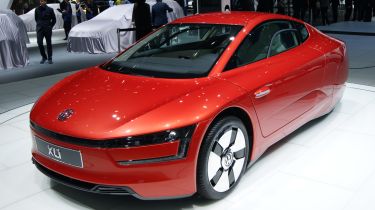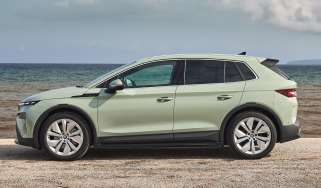Volkswagen XL1
We drive the innovative new 313 mpg Volkswagen XL1 ahead of its arrival in showrooms this year

In technology terms, this is a five star car if ever there was one. But VW isn’t playing ball with potential customers over pricing. The £30,000 price tag mentioned two years ago may rocket to nearer £50,000 when the car arrives in showrooms this year. For that reason, and the fact it’s far from perfect to drive, the XL1 loses one star but retains a well-deserved four.
Supercars aside, the Volkswagen XL1 is the most dramatic looking product to hit UK showrooms in years. Undoubtedly, it’s a mould-breaker – production cars don’t come more efficient or aerodynamic than this – so when we were offered the opportunity to drive it from Lucerne to the Geneva Motor Show, we leapt at the chance.
VW’s factory in Osnabruck, Germany has already built dozens of XL1s, and is committed to making at least 250 during this, the initial production stage. It’s covering itself by saying that it will only build more if there’s sufficient demand from paying consumers. But if – and it’s a big if – it proves to be the “affordable” two seater that VW vows it wants it to be, consumers will queue for it.
Almost certainly it will be offered on long term leasing rather than outright purchase deals, and if the price is right forget hundreds of XL1’s on the road - production levels will be in the thousands… or even tens of thousands.
More reviews
Car group tests
- Abarth Punto vs Corsa SRi
- Mercedes GLA vs Alfa Romeo Tonale 2024 twin test: premium plug-in hybrids go head-to-head
- Alpina XD3 Biturbo vs Porsche Macan S Diesel
- The best long-term car tests 2022
- Ariel Nomad
- Audi S3 vs BMW M135: which German brand builds the hottest hatchback?
- Volkswagen Touareg vs Audi Q8: an SUV sibling rivalry
- Range Rover vs Bentley Bentayga: 2022 twin test review
- BMW Z car supertest: Z1, Z3, Z4 and Z8 help us celebrate 35 years of Bavarian roadsters
- BMW 128ti vs Volkswagen Golf GTI: understated hot hatches have plenty of used appeal
In-depth reviews
- Abarth 600e review
- Abarth 124 Spider review
- Abarth Punto (2008-2015)
- Alfa Romeo Tonale review
- Alfa Romeo Stelvio review
Long-term tests
- Alfa Romeo Tonale PHEV long-term test: things are looking bright thanks to our stylish SUV
- Alpine A110 GT: long term test
- BYD Dolphin Design long-term test: compact EV is a near-perfect family runaround
- DS 4 E-Tense 225: long-term test review
- Fiat 500: long-term test review
- Genesis GV60 Premium long-term test: our upmarket EV is practical as well as posh
- Genesis Electrified GV70 long-term test: great for a family road trip
- Honda e:Ny1 Advance long-term test: small boot shrinks EV’s appeal
- Jaguar F-Pace PHEV: long-term test review
- Jeep Avenger Summit long-term test: a good all-round electric SUV
Road tests
- New AC Cobra 378 Superblower 2021 review
- New AC Cobra 378 review
- New Alfa Romeo Stelvio 2023 review
- New Alfa Romeo Giulia 2023 review
- New Alpina B3 Touring 2023 review
- Alpine A110 R 2024 review: almost the perfect sports car
- New Alpine A110 S 2022 review
- New Alpine A110 Legende GT 2021 review
- New Aston Martin DBX707 2024 review: updated interior transforms Aston’s super-SUV
- New Aston Martin Vantage 2024 review: Britain's answer to the Porsche 911 Turbo
Used car tests
- Used Alpine A110 (2017-date) review
- Used Audi A6 (Mk5, 2018-date) buyer’s guide: classy exec is a great family car
- Used Bentley Continental GT (Mk3, 2018-date) review
- Used BMW Z4 (Mk3, 2019-date) buyer’s guide: a worthy Porsche Boxster rival
- Used Cupra Formentor (Mk1, 2020-date) buyer's guide: stylish and family-friendly
- Used Dacia Sandero (Mk3, 2020-date) review: all the essentials at a low price
- Used Ford Kuga Mk3 (2020-date) review: a popular and desirable mid-size SUV
- Used Ford Puma (2020-date) review: an impressive SUV that’s great to drive
- Used Honda Jazz (MK4, 2020-date) review: a reliable supermini with plenty of space
- Used Honda e (Mk1, 2020-2024) review: limited range, but a desirable city EV
VW UK has placed a provisional order for 50 and, after this initial batch, it has an option to take more. But the car is built – and will continue to be built – in left-hand-drive only. That’s non-negotiable.
On the XL1 prototype we drove two years ago, the scissor doors were heavy, awkward and a bad fit. Since then it has spent tens of millions trying to perfect them, and if the two production versions I drove in Switzerland last week were anything to go by, these flaws are now history. It’s still difficult to get in over the wide sills, and rear visibility is pretty much non-existent, but the cabin itself is stylish and high quality.
The XL1 has two ‘engines’ beneath its bodywork – one electric, one diesel. Depending on how the driver behaves, they work in isolation or together. Assuming you start out with a fully or partly recharged battery pack, you can press the EV button in the centre of the featherweight dashboard (it’s made of wood pulp) and accelerate away gently in silent, all-electric mode. Even if you forget to press the switch, the car will decide for you that electric mode is the best option in such circumstances.
In pure electric mode the XL1 can happily purr along slowly for up to 31 miles, VW says. Alternatively, the electric motor and two-cylinder diesel engine can team-up to propel the car at greater speeds, thereby enabling it to travel a maximum of about 310 miles on a single 10-litre tank of diesel.
The Sanyo electric motor will take the lead role when, for example, gently driving up to and stopping at a red traffic light. Then the diesel (it’s a 1.6-litre Polo TDI engine sawn in half) kicks in when the lights turn green, the accelerator is floored for rapid getaway and the fast, open road beckons.
Once you hit the throttle hard, the diesel engine kicks in with a slightly alarming clatter. It’s not too bad, but is enough to surprise you following the silence of the electric motor. The XL1 will hit 62mph in 12.7 seconds and is limited to 99mph, so it’s far from quick. But this car is focused on showcasing technology, not beating top speed records.
And don’t expect pin-sharp handling, either. The steering is unassisted, so feels heavy and gives a sense that the XL1 is a little sluggish through the bends. In reality, it’s actually quite agile but you really need to work hard to get the best out of it.
You must try the XL1 before you buy. The noisy diesel isn’t for everyone and neither is the patient, less-is-more driving technique that’s required to extract the best out of the maverick machine. The staggered seating arrangement, small boot that can’t swallow a suitcase, and total absence of sun visors and mirrors (expensive rear view cameras are on board) will not be to everyone’s tastes either.
As for the price, nobody knows. Not even Volkswagen. Its original plan was to sell or lease the XL1 for about the same price as three basic Polos. Now it’s three Golfs. Thus the likely 50 grand price tag. Ouch!








